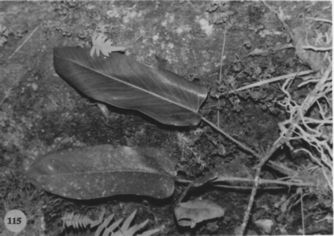






Anthurium nakamurae Matuda,
Revista Soc. Mex. Hist. Nat. 11: 93, Fig. 2. 1950. TYPE: Mexico. Chiapas: Cascada, Siltepec, elev. 1,200 m, June 2, 1949. Matilda 18668 (MEXU-85863, holotype).
Epiphyte; stems very short; roots thick, green, descending; cataphylls subcoriaceous, 4-6 cm long, tinged red-violet, acuminate at apex with short subapical apiculum, drying medium brown (B & K Yellow 4/2.5), weathering into reticulate fibers.
LEAVES erect to spreading; petioles 10.5-40 cm long, 4-5 mm diam., usually terete, sometimes subterete to weakly sulcate; geniculum 1.5-2 cm long; blades lanceolate to narrowly triangular, acuminate at apex, truncate to weakly lobed at base, 14.5-45 cm long, 4.5-12 cm wide, broadest at middle or just above; the anterior lobe 15-42 cm long, the margins straight, sometimes convex in apical one half of blade; posterior lobes 2-5 cm long; sinus arcuate with petiole decurrent to parabolic; both surfaces semiglossy; midrib flat at base above, raised near middle, sunken at apex, raised below; basal veins 2-3 pairs, free to base, flat and ± obscure above, prominulous below; primary lateral veins 10-12 per side, departing midrib at 30° angle, flat and ± obscure above, flat to prominulous below; lesser veins obscure above and below; collective vein usually arising from the first or second basal vein, sometimes from one of the primary lateral veins near the base, flat above, prominulous below, 3-5 mm from the margin.
INFLORESCENCE spreading, equal to or longer than leaves; peduncle 30-47 cm long, 3-5 mm diam.; spathe thin, lanceolate to narrowly ovate, green heavily tinged red-violet, 4.5-6 cm long, 1.9-2.5 cm wide, long-acuminate at apex, weakly cordate at base, inserted at 90° angle on peduncle; spadix sessile or stipitate, the stipe sometimes to 1 cm (rarely to 4 cm long), olive-green or purple, 3.5-8.2 cm long, 6-7 mm diam. at base, 3-5 mm diam. at apex; the flowers 4-lobed, 3.2-3.5 mm long, 2.6-3.3 mm wide, the sides sigmoid; 5-6 flowers visible in the principal spiral, 8-10 flowers visible in the alternate spiral; tepals matte, densely papillate, lateral tepals 1-1.6 mm wide, the inner margin convex, turned up, the outer margins tinged red-violet; pistils emergent, red-violet; stigma linear, ca. 0.2 mm long, scarcely open; stamens developing rapidly from the base, the laterals first, followed quickly by the alternates, the leading stamens emerging only 1-2 spirals ahead of the third and fourth stamens; anthers pale yellow, 0.6 mm in both directions, held over pistil, retracting to edge of tepals but not contiguous; thecae ellipsoid, scarcely divaricate; pollen bright yellow, fading to while.
INFRUCTESCENCE pendent; spathe persistent; spadix to 17 cm long; berries red, obovoid, round at apex, ca. 10 mm long, 7 mm wide; seeds 2, pale green, flattened, 5-6 mm long, ca. 3 mm wide. Figs. 114 and 115.
Anthurium nakamurae is apparently endemic to eastern Chiapas in the vicinity of Siltepec and La Grandeza at elevations of 1,200 to 2,100 m. My collection was made in a cloud forest area that appeared to be either tropical wet forest or premontane rain forest. The species is a member of section Belolonchium and is characterized by its usually subterete, sometimes weakly sulcate petiole, its moderately thick, oblong to oblong-elliptic leaf blade, which is usually truncate (rarely subcordate) at the base and usually broadest above the base. Blades are often weakly constricted somewhat above the base. Anthurium nakamurae is most similar to A. parvispathum, which has leaf blades oblong to oblong-elliptic with the base rounded to truncate, but that species differs in having much thicker blades that are generally much paler and matte on the lower surface. Moreover, typical A. parvispathum is usually found growing on rocks while A. nakamurae is reported principally epiphytic and, where I have seen it, grows high up in trees. Two collections made by Breedlove (31955 and 40413) vary somewhat in the thickness of the blade and in having relatively longer cataphylls that appear to persist intact rather than weather to reticulate fibers as in typical A. nakamurae.
 |
 |
 |
Mexico Chiapas: 2000-2400 m,, , Breedlove & Bartholomew 55953 (CAS).
Mexico Chiapas: 2016 m,, 19 May 1945, Matuda 5576 (LL).
Mexico Chiapas: Mun. Siltepec, 2000-2400 m,, 1 Feb. 1982, Breedlove
& Almeda 58231 (CAS).